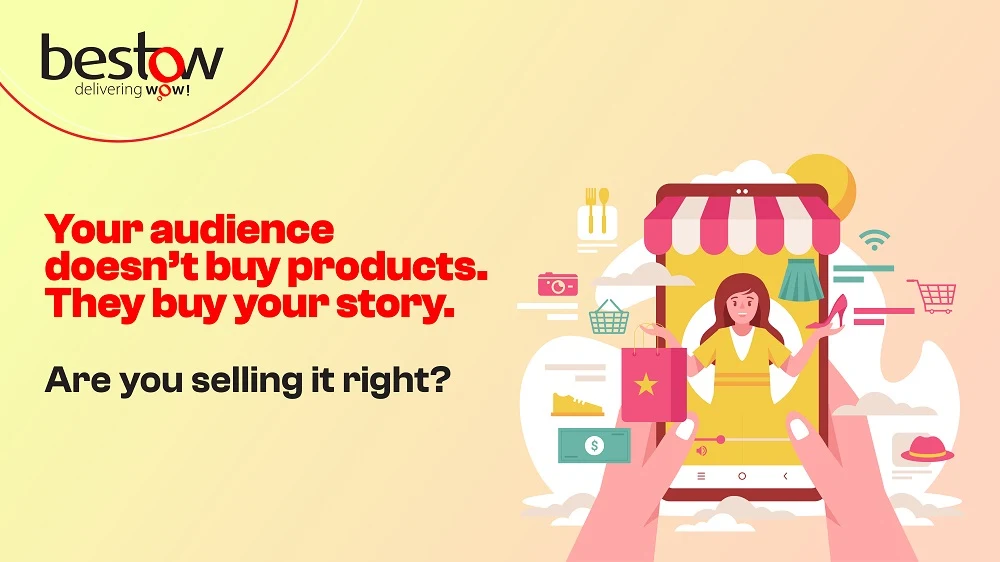Brand Storytelling: From Facts to Feelings – The Role of Emotion in Brand Storytelling

17/07/2025
Start Listening
Brand Storytelling: From Facts to Feelings – The Role of Emotion in Brand Storytelling
Ask any marketing strategist, and you’ll hear definitions ranging from “the narrative of your brand” to “how your brand communicates its mission.” But strip away the buzzwords, and brand storytelling is simply this: the art of using words, visuals, and experiences to make people care about your brand.
Yet, there’s one core element that elevates brand storytelling from an information-sharing exercise to a powerful tool that shapes perception and drives action: emotion.
In today’s hyperconnected, content-saturated world, brands no longer compete on product features alone. They compete on the meaning they create in people’s lives. This blog will discuss all aspects of brand storytelling to help you understand why it is the need of the hour.

What Is Brand Storytelling?
Brand storytelling is the strategic use of narrative to communicate your brand’s values, purpose, and offerings in a way that resonates with your audience emotionally.
It combines:
Your origin story (how you started, why you exist)
Your mission and vision (what you stand for)
Your customer stories and experiences (real-life proof of impact)
The tone, visuals, and personality you consistently express
Ultimately, it is about creating a cohesive narrative that builds trust, evokes emotion, and drives loyalty. Brand storytelling is not an isolated campaign; it is the heartbeat of your communication strategy.
Why Is Emotion Important in Brand Storytelling?
Humans are emotional decision-makers first, rational thinkers second.
Studies show 95% of purchasing decisions are subconscious and emotion-driven.
Neuroscientist Antonio Damasio found that people with impaired emotions struggle to make decisions, even when they can list pros and cons logically.
Emotion shapes memory. People remember how you made them feel far more than what you told them.
Think about it:
When Nike tells the story of an underdog athlete, are they selling rubber soles or igniting the emotion of “Just Do It”?
When Dove shares stories of real women embracing their natural beauty, are they selling soap or the feeling of self-acceptance?
Emotion in storytelling:
Builds trust (people buy from brands they feel connected to)
Creates recall (emotions enhance memory encoding)
Inspires action (fear, joy, pride, hope trigger decisions)
At Bestow, we believe stories are what people remember long after they’ve forgotten your features and benefits.
Get in touch with our experts to craft yours. How Do Brands Use Storytelling to Connect With Customers Emotionally?
Here are brand storytelling strategies for 2025 that leverage emotion effectively:
1. Authenticity Over Perfection
Customers crave authenticity. In an era of AI-generated content and glossy ads, honest, human-centric stories stand out. Share your challenges, behind-the-scenes moments, and lessons learned. Vulnerability fosters trust.
Example:
Ben & Jerry’s regularly tells stories about their founders’ struggles, social justice missions, and why they take strong political stances, building emotional alignment with their socially conscious consumers.
2. Customer-Centric Narratives
The most powerful brand stories place the customer as the hero, not the brand.
Instead of saying, “We’re the best digital marketing agency,” frame it as, “Here’s how our client went from struggling with leads to becoming an industry leader with our strategies.”
Example:
Apple’s “Shot on iPhone” campaign turns customers into storytellers, showcasing their creativity and lives – subtly positioning the iPhone as the enabler of their expression.
3. Visual and Sensory Storytelling
2025 demands that brands move beyond words to immersive experiences.
Use video storytelling to show real emotions.
Incorporate AR/VR for interactive brand experiences.
Harness audio storytelling (podcasts, sonic branding) to trigger nostalgia or excitement.
Example:
Coca-Cola’s AR-enabled bottles that unlock animated stories when scanned, bringing its “Share a Coke” campaign to life with personalisation and delight.

4. Purpose-Driven Storytelling
Modern consumers support brands that stand for something meaningful.
Your brand’s social impact stories – sustainability initiatives, inclusivity campaigns, community support – build an emotional bond based on shared values.
Example:
Patagonia’s “Don’t Buy This Jacket” ad urged consumers to buy less to save the planet. This new consumer trend was counterintuitive yet deeply emotional, aligning with eco-conscious buyers’ values. Learn more about such consumer trends in 2025 .
5. Emotional Archetypes
Brands often use Jungian archetypes to build emotional resonance, such as:
The Hero (Nike, BMW) – Inspiring achievement
The Caregiver (Johnson & Johnson) – Safety and comfort
The Rebel (Harley Davidson) – Freedom and non-conformity
The Innocent (Coca-Cola) – Optimism and nostalgia
Using a consistent archetype in storytelling anchors your brand emotionally in your audience’s mind.
6. Story Listening Before Storytelling
In 2025, brands are prioritising social listening and audience insights to tailor storytelling to what their customers actually care about.
By monitoring conversations, feedback, and emotional triggers, brands can craft stories that feel personally relevant, rather than generic campaigns.

What Are the Key Elements of Effective Brand Storytelling?
| Authenticity | Be real, honest, and vulnerable. |
|---|---|
| Relatability | Know your audience’s desires, struggles, and dreams. |
| Conflict and Resolution | Every story needs tension; show how your brand solves pain points. |
| Emotional Connection | Inspire, motivate, comfort, or empower. |
| Consistency | Across platforms, maintain your tone, visuals, and brand personality. |
| Purpose | Go beyond selling; show why your brand exists and the impact it creates. |
Can Storytelling Increase Brand Loyalty?
Absolutely.
Emotional storytelling:
Builds trust and familiarity, key drivers of loyalty.
Helps customers identify with your brand on a deeper level, making them ambassadors rather than passive buyers.
Encourages repeat purchases because they see themselves reflected in your brand’s journey.
According to a study by Harvard Business Review , emotionally connected customers are 52% more valuable than highly satisfied customers, spending more and recommending more often.
How Does Emotional Storytelling Influence Buying Decisions?
Creates urgency (fear of missing out)
Inspires aspiration (the life they want to live)
Triggers comfort (feeling safe and supported)
Builds belongingness (being part of a community or movement)
In essence, emotional storytelling bridges the gap between product features and personal relevance, influencing not only the purchase but brand preference and advocacy.
What Are Some Examples of Successful Brand Storytelling Campaigns?
1. Always – #LikeAGirl
Transformed a common insult into an empowering movement. The campaign connected deeply with young women, sparking global conversations and reshaping brand perception.
2. Airbnb – Belong Anywhere
Showcased hosts’ and travellers’ stories to evoke feelings of belonging, cultural exploration, and warmth, positioning Airbnb as more than an accommodation service.
3. Google – Reunion Ad
This emotional ad told the story of two childhood friends separated by India-Pakistan partition, reunited via Google Search. It wasn’t about features, but about feelings – nostalgia, love, and connection.
4. Nike – Dream Crazy
Featuring Colin Kaepernick, it stood for social justice, resilience, and courage, aligning with Nike’s archetype as the Hero, driving loyalty among its core audience.
Is Emotional Marketing More Effective Than Fact-Based Marketing?
Emotion and facts work best together.
Facts inform the rational mind. Emotion drives the subconscious mind to act.
However, emotional marketing often outperforms purely fact-based campaigns because:
It cuts through content fatigue
Creates stronger memory associations
Drives immediate action due to emotional triggers
That said, back your emotional storytelling with proof – quality, service, impact metrics – to build credibility.

How Can Small Businesses Use Storytelling in Their Marketing?
You don’t need big budgets for powerful storytelling.
1. Share Your Founder’s Story
Why did you start your business? What problem were you solving? Real, humble beginnings build relatability.
2. Highlight Customer Stories
Share testimonials as stories. Instead of “Great service!”, tell the customer’s journey: problem, solution, transformation.
3. Show Behind-the-Scenes
Let your audience peek into your process, team culture, and challenges. People buy from people they know and like.
4. Be Consistent on Social Media
Use Instagram Stories, LinkedIn posts, and reels to communicate your brand voice regularly in an authentic, engaging way.
What Mistakes Should Brands Avoid in Emotional Storytelling?
| Overdramatization | Forced emotions feel manipulative. Be authentic. |
|---|---|
| Irrelevance | Ensure your story aligns with your brand’s purpose and audience. |
| Inconsistency | Using different tones on different platforms confuses your audience. |
| Ignoring Data | Storytelling must be audience-informed, not brand-centric fantasies. |
| Neglecting Follow-through | Don’t promise a feeling you can’t deliver through your actual products/services. |
How Do You Measure the Impact of Brand Storytelling?
While storytelling feels intangible, its impact can be measured through:
| Engagement metrics | Likes, shares, comments, saves, DMs |
|---|---|
| Sentiment analysis | Positive, neutral, negative mentions across platforms |
| Brand recall surveys | Do customers remember your message? |
| Conversion rates | Did the story-driven campaign drive sales or leads? |
| Customer loyalty metrics | Repeat purchase rates, customer lifetime value |
| Direct feedback | Reviews and testimonials mentioning how your story resonated |
Brand Storytelling Strategies for 2025: The Road Ahead
1. AI-Powered Personalisation
The future of digital marketing will require brands to use AI to deliver hyper-personalised stories at scale, tailored to individual customer interests and behaviours.
2. Interactive Storytelling
Polls, quizzes, AR filters, and choose-your-own-adventure formats will enhance engagement, making audiences part of the story.
3. Inclusive Storytelling
Telling diverse, inclusive stories that represent different identities and communities authentically will be a non-negotiable.
4. Purpose-Led Campaigns
Brands with a clear social or environmental mission will stand out in a value-driven marketplace.
5. Short-Form Storytelling
With shrinking attention spans, brands will master storytelling in under 30 seconds while retaining emotional depth.
Go From Facts to Feelings With Bestow!
Brand storytelling isn’t just about telling people what you do. It’s about showing them who you are and how you make their lives better.
Facts will always have a place in marketing. They educate, inform, and rationalise decisions. But it is feelings that create movements, drive loyalty, and inspire purchase decisions.
At Bestow, we help brands craft compelling narratives that go beyond product features to touch hearts, build connections, and drive action. Whether you’re looking to develop a brand storytelling strategy for 2025, launch an emotion-driven campaign, or refine how to tell your brand’s story authentically, our team is here to guide you.
Let’s build stories that don’t just reach your audience, but resonate with them for life.
Get in touch to learn more! FAQs
Emotion plays a vital role in brand storytelling because it captures attention, enhances memory, influences decision-making, and fosters customer loyalty, making the brand more memorable and impactful.
Brands connect emotionally with customers by crafting authentic, relatable narratives that highlight a clear purpose and position the customer as the central figure in the story.
Effective brand storytelling typically includes authenticity, emotional resonance, relatability, consistency, a defined purpose, and a narrative arc that involves conflict and resolution.
Yes, storytelling can significantly increase brand loyalty by building trust and forming deeper, more meaningful relationships with customers over time.
Emotional storytelling influences buying decisions by tapping into subconscious motivators such as aspiration, urgency, or the desire to belong, leading to quicker and more decisive purchases.
Notable examples of successful brand storytelling include Always’ #LikeAGirl, Airbnb’s Belong Anywhere, Google’s Reunion, and Nike’s Dream Crazy campaigns.
Emotional marketing tends to be more persuasive than fact-based marketing, although the most effective campaigns combine emotional appeal with credible facts to strengthen the message.
Small businesses can use storytelling by sharing the founder’s journey, showcasing customer success stories, offering behind-the-scenes glimpses, and maintaining a consistent voice across all marketing channels.
Brands should avoid common pitfalls such as overdramatization, lack of relevance, inconsistency, neglecting data, or making promises they cannot fulfill.
The effectiveness of brand storytelling can be measured through engagement metrics, sentiment analysis, brand recall, conversion rates, customer loyalty indicators, and direct feedback from the audience.
Categories
Recent Blogs
Send us a message
We'd love to hear from you
Let's build a plateform that works for you busines and the advertisers who trust it.
Talk to Our Expert